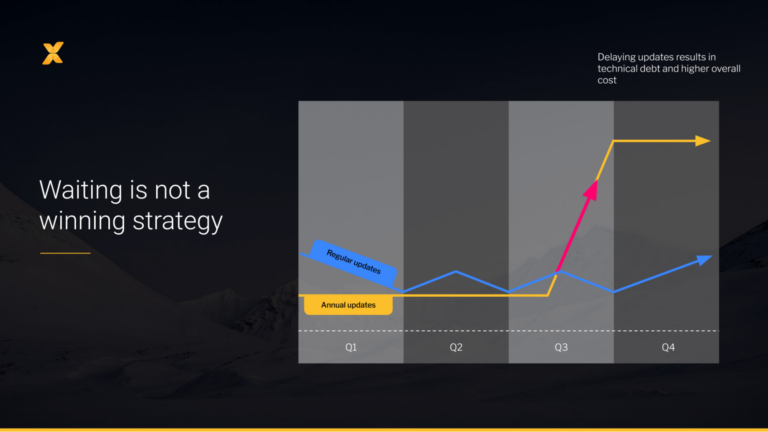As the ecommerce market grows increasingly competitive, merchants are constantly looking for ways to stand out and stay ahead. Serverless ecommerce technology holds a lot of promise and offers a compelling option for ecommerce in B2B and B2C companies.
TABLE OF CONTENTS
Consumer Expectations are Evolving
Ecommerce today is far more than a medium to sell products online. The expectations consumers have on brands keep increasing, and offering personalized experiences and recommendations is becoming a hygiene factor. Customizing the shopping journeys tailored to each buyer is one of the most efficient ways to fuel sales. But creating a truly personalized shopping experience requires the right technology, experience, and know-how.
However, one thing is certain: there’s no turning back. All kinds of ecommerce, from B2C and D2C to B2B, are evolving at high speed. The only way to keep up is to take bold action and continuously update everything from digital strategy and tech stack to internal processes and skill levels. In this context and in light of these fast-paced changes, more and more brands are now turning to serverless ecommerce to increase performance and capabilities and, ultimately, drive more sales.
In this article, we’ll discuss some of the pros and cons of going serverless to help you understand how this opportunity may fit into your digital roadmap. But first, let’s have a look at what serverless ecommerce is.
Related reading: Selecting an Enterprise Ecommerce Hosting Service
What is Serverless Ecommerce
Serverless ecommerce is a term describing ecommerce platforms that can work in serverless mode within a cloud hosting provider’s data center. A more general word for the same technology is serverless computing, referring to the operation of any digital application in serverless mode.
Serverless computing is a cloud-native development model that allows development teams to develop and run applications without needing to manage servers. Of course, there are still servers in a “serverless” setup, but the servers are abstracted away from the app development.
So why is serverless a good solution for ecommerce in particular? Well, because ecommerce platforms often entail complex and extensive capabilities and features used to create unique and personalized customer experiences. To create those experiences, ecommerce platforms also require large amounts of data. At the same time, fewer and fewer companies have their own physical servers, and many brands have moved their data storage and processing to the cloud.
It’s against this backdrop that serverless computing is gaining ground. And turning to managed services allows brands to handle the backend processing and data while their internal teams are freed up to spend their time and budget on innovation and sales.
Related reading: Ecommerce Evolution: Platform-based vs Composable Architecture
When to Go Serverless?
For a vast majority, the question of going serverless is less about if and more about when. And as always, the first step to getting ahead is getting started. Every CIO needs to consider whether a switch to serverless architecture is suitable for their team’s platform and what such a switch would mean.
While change is always a bit scary, there are massive rewards for those who take the leap. Going from a traditional on-prem model where you install, host, and maintain your own hardware to a modern and streamlined cloud model can significantly impact your budget, capabilities, and downtime. As Olga Gutenko, Head of Technology Services at Vaimo, explains:
“Traditional hosting involves running your business on physical servers, either on a dedicated server or on a shared server space. While this approach is a cost-efficient way to host a website, it creates a single point of failure. This means that if anything happens to this server, such as the failure of the hard drive, RAM, or power supply, it affects your business.”
The intersection of virtualization and containerization helps brands use fewer resources and assures the internal team that only the systems and platforms that are needed at any given time are running in tandem, in the most optimized combination. Internal teams can then shift their focus to the functionality, innovation, and personalization of their ecommerce platform.
The VTEX ecommerce platform stands out as an innovative player in the serverless ecommerce field. The combination of the VTEX platform and Amazon Web Services Cloud hosting makes for a high-performing SaaS and serverless architecture-based ecommerce experience. The agility and ease of changes to the UX in this model allow brands to react on the fly to changes in product trends and surges, popularity and scarcity, as well as over-reaching events like Black Friday and Cyber Monday. This means marketing teams can focus their efforts on simplifying the path to conversion for their shoppers, lowering abandonment, and increasing online revenue.
Related reading: Five Ways to Hit Gold with Digital Experience
4 Benefits of Serverless Ecommerce
Increased Resilience, Security, and Less Downtime
Letting go of control and the daily maintenance of your ecommerce experience can sound like a relief but perhaps also a little scary. After all, serverless hosting companies are subject to failure and downtime, just like everyone else.
On the other hand, your up-time is their sole focus, and if you subscribe to a reputable hosting provider like AWS and an outage occurs, it’s likely that a large portion of the internet will experience the same outage. Consumers are much less likely to hold a grudge if your site is interrupted, along with the likes of Amazon and Nike.
Related Reading: Ecommerce Security: A Comprehensive Guide
Improved Scalability
Serverless architecture and cloud-based models add power and scalability to your business, allowing you to adapt and scale up or down as your audience and demand change. The cloud and a serverless setup also allow you to increase both automation and efficiencies and enable you to offer lower prices and improved functionality.
Adding a system like Kubernetes to this cocktail can push this further by compartmentalizing like-logic functionality into separate pods so that changes and upgrades can be deployed instantly without disrupting the other pieces of your ecommerce experience.
Related reading: The benefits of Kubernetes
Reduced Costs
With a serverless architecture, costs are based on usage at the granular level. What this means is that brands are only paying for what they use. For example, if your ecommerce platform uses server space to push new functionality or run active or responsive promotions, you will only pay for that specific amount of server capabilities.
Compared to running on-premise servers, the cost reductions made possible by solutions like Amazon Web Services offer immense opportunities for cost savings. As XaaS models continue to increase and live in the cloud, brands can see savings across the IT environment, including hosting, software, systems, and optimization.
Early adopters will take advantage of new cloud technologies as they arise, and by doing so, they will also avoid the technical debt that comes from holding on to older, heavier tech stacks.
A Future-proof Solution
Today, retailers are quickly embracing serverless ecommerce, and tomorrow, as emerging technologies enjoy the benefits of the space, the retail revolution will deliver fast, headless, and accessible experiences.
But retail is just one side of the coin. As B2B buying expectations change and evolve, the benefits of the serverless model will also become relevant for the manufacturing, distribution, and marketplace models. Companies of all sizes and industries will benefit from the streamlined approach that comes with serverless and the increased availability of their development teams. Going serverless allows dev teams to focus on strategic ecommerce projects that increase customer loyalty and conversion and will enable businesses to shift their focus to increased innovation and robust CX.
Related reading: Seamless Customer Experience – Why it Matters and How to Deliver
How Vaimo Can Help
At Vaimo, we’re experts in all things ecommerce. We’re very flexible and can cater to your needs, whether you choose to go fully cloud-native or on-premise setup. We’re a full omnichannel agency and one of the world’s most respected leaders in digital commerce.
Get in touch with our team of experts to learn how we can help you.








